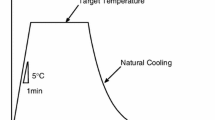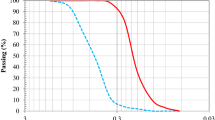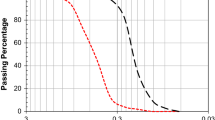Abstract
This paper presents the stress–strain curves of reactive powder concrete (RPC) specimens in compression tested at increasing temperatures to study the fire resistance of RPC. Stress–strain tests were conducted at various temperatures (20, 200, 400, 600 and 800 °C), and the decomposition phases and microstructure changes were identified using X-ray diffraction and a scanning electron microscope (SEM). The results indicate that RPC with steel fibres exhibits ductility at temperature beyond 400 °C. The compressive strength and elastic modulus of RPC with steel fibres decrease with temperature, whereas the peak strain increases. The energy absorption capacity increases at increasing temperature below 400 °C, but decreases above 400 °C. The steel fibre content does not affect compressive strength and elastic modulus. The SEM images show distinct structural changes corresponding to the deterioration of RPC at elevated temperatures. Property predictive models defined in this paper can be used as input data for computer programs to evaluate the structural fire response at elevated temperatures.





















Similar content being viewed by others
References
Richard P, Cheyrezy M (1995) Composition of reactive powder concrete. Cem Concr Res 25(7):1501–1511
Richard P, Cheyrezy MH (1994) Reactive powder concretes with high ductility and 200–800 MPa compressive strength. ACI Special Publication, vol 144, pp 507–518
Diederichs U, Jumppanen UM, Penttala V (1988) Material properties of high strength concrete at elevated temperatures. In: IABSE 13th congress, Helsinki, June 1988
Furumura F, Abe T, Shinohara Y (1995) Mechanical properties of high strength concrete at high temperatures. In: Proceedings of the fourth Weimar workshop on high performance concrete: material properties and design. Hochschule für Architektur und Bauwesen (HAB), Weimar, Germany, 4–5 October 1995, pp 237–254
Li W, Guo ZH (1993) Experimental investigation on strength and deformation of concrete under high temperature. Chin J Build Struct 14(1):8–16
Lee J, Xi Y, Willam K, Jung Y (2009) A multiscale model for modulus of elasticity of concrete at high temperatures. Cem Concr Res 39(9):754–762
Cheng FP, Kodur VKR, Wang TC (2004) Stress–strain curves for high strength concrete at elevated temperatures. J Mater Civ Eng 16(1):84–94
Poon CS, Shui ZH, Lam L (2004) Compressive behavior of fibre reinforced high-performance concrete subjected to elevated temperatures. Cem Concr Res 34(12):2215–2222
Ding Y, Azevedo C, Aguiar JB, Jalali S (2012) Study on residual behaviour and flexural toughness of fibre cocktail reinforced self compacting high performance concrete after exposure to high temperature. Constr Build Mater 26(1):21–31
Tai YS, Pan HH, Kung YN (2011) Mechanical properties of steel fibre reinforced reactive powder concrete following exposure to high temperature reaching 800 °C. Nucl Eng Des 241(7):2416–2424
Castillo C, Durrani AJ (1990) Effect of transient high temperature on high-strength concrete. ACI Mater J 87(1):47–53
Zaidi KA, Sharma UK, Bhandari NM (2012) Effect of temperature on uni-axial compressive behavior of confined concrete. Fire Saf J 48:58–68
Rashad AM, Bai Y, Basheer PAM, Collier NC, Milestone NB (2012) Chemical and mechanical stability of sodium sulfate activated slag after exposure to elevated temperature. Cem Concr Res 42(2):333–343
Khaliq W, Kodur VKR (2011) Thermal and mechanical properties of fibre reinforced high performance self-consolidating concrete at elevated temperatures. Cem Concr Res 41(11):1112–1122
FIB Bulletin 38 (2007) Fire design of concrete structures—materials, structures and modelling. The International Federation for Structural Concrete (fib–Fédération Internationale du Béton), Switzerland
British Standards Institution (2004) Eurocode 2: Design of concrete structures—Part 1.2: general rules—structural fire design. BS EN 1992-1-2: 2004
Mehta PK, Monteiro PJM (1993) Concrete: structure, properties and materials, 2nd edn. Prentice Hall International, New Jersey, p 139
British Standards Institution (2005) Eurocode 4: design of composite steel and concrete structures—Part 1.2: general rules-structural fire design. BS EN 1994-1-2: 2005
Lie T (1992) Structural fire protection. ASCE Committee on Fire Protection, Structural Division, American Society of Civil Engineers, New York, pp 225–229
Seleem HH, Rashad AM, Elsokary T (2011) Effect of elevated temperature on physic-mechanical properties of blended cement concrete. Constr Build Mater 25:1009–1017
Chan SYN, Peng GF, Anson M (1999) Residual strength and pore structure of high-strength concrete and normal-strength concrete after exposure to high temperatures. Cem Concr Compos 21(1):23–27
American Concrete Institute (1989) Guide for determining the fire endurance of concrete elements. ACI 216R-89, Detroit
Furumura F, Abe T, Shinohara Y (1995) Mechanical properties of high strength concrete at high temperatures. In: Proceedings of the fourth Weimar workshop on high performance concrete: material properties and design. Hochschule für Architektur und Bauwesen (HAB), Weimar, Germany, 4–5 October 1995, pp 237–254
Lu ZD (1989) Research on fire response of reinforced concrete beams. PhD Thesis, Tongji University
Dougill JW (1968) Some effects of thermal volume changes on the properties and behavior of concrete. The Structure of Concrete, Cement and Concrete Association, London, pp 499–513
Roux FJP (1974) Concrete at elevated temperature. PhD Thesis, University of Cape Town
Fu YF, Wong YL, Poon CS, Tang CA, Lin P (2004) Experimental study of micro/macro crack development and stress–strain relations of cement-based composite materials at elevated temperatures. Cem Concr Res 34(5):789–797
Chang YF, Chen YH, Sheu MS, Yao GC (2005) Residual stress–strain relationship for concrete after exposure to high temperatures. Cem Concr Res 36(10):1999–2005
Khennane A, Baker G (1993) Uniaxial model for concrete under variable temperature and stress. ASCE J Eng Mech 119(8):1507–1525
Comites Euro-International Du Beton (1991) Fire design of concrete structures-in accordance with CEB/FIP Model Code 90. CEB Bulletin D’Information No. 208, Switzerland, July 1991
Schneider U (1986) Modeling of concrete behaviour at high temperature. In: Anchor RD, Malhotra HL (eds) Design of structures against fire. Elsevier, Amsterdam, pp 53–69
Anderberg Y, Thelandersson S (1976) Stress and deformation characteristics of concrete, 2-experimental investigation and material behaviour model. Bulletin 54, University of Lund, Sweden
Li LY, Purkiss J (2005) Stress–strain constitutive equations of concrete material at elevated temperatures. Fire Saf J 40(7):669–686
Taerwe LR (1992) Influence of steel fibres on strain—softening of high strength concrete. ACI Mater 88(6):54–60
Nataraja MC, Dhang N, Gupta AP (1999) Stress–strain curves for steel fibre reinforced concrete under compression. Cem Concr Compos 1999(21):383–390
Zheng W, Luo B, Wang Y (2014) Microstructure and mechanical properties of reactive powder concrete with polypropylene fibres at elevated temperatures. Mag Concr Res 66(1):1–12
Bakhtiyari S, Allahverdi A, Rais-Ghasemi M, Zarrabi BA, Parhizkar T (2011) Self-compacting concrete containing different powders at elevated temperatures—mechanical properties and changes in the phase composition of the paste. Thermochim Acta 514:74–81
Demirel B, Keleştemur O (2010) Effect of elevated temperature on the mechanical properties of concrete produced with finely ground pumice and silica fume. Fire Saf J 45:385–391
Taylor HFW (1990) Cement chemistry. Academic Press, New York
Peng GF, Chan SYN, Anson M (2001) Decomposition in hardened cement paste subjected to elevated temperatures up to 800 °C. Adv Cem Res 13(2):47–52
Peng GF, Huang ZS (2008) Change in microstructure of hardened cement paste subjected to elevated temperatures. Constr Build Mater 22(4):593–599
Dweck J, Buchler PM, Vieira Coelho AC, Cartledge FK (2010) Hydration of a Portland cement blended with calcium carbonate. Thermochim Acta 346:105–113
Ukrainczyk N, Ukrainczyk M, Šipušić J, Matusinović T (2006) XRD and TGA investigation of hardened cement paste degradation. In: 11th conference on materials, processes, friction and wear, MATRIB’06, Vela Luka, pp 243–249
Lau A, Anson M (2006) Effect of high temperatures on high performance steel fibre reinforced concrete. Cem Concr Res 36(9):1698–1707
Acknowledgments
The authors gratefully acknowledge the financial support from the Changjiang Scholar Program of China (2009–37), the PhD Programs Foundation of Ministry of Education of China (20092302110046) and the Natural Science Foundation of Heilongjiang Province (E200916). The authors also gratefully acknowledge Hai-tao Qu for his assistances in preparing and testing the specimens for the research.
Author information
Authors and Affiliations
Corresponding author
Rights and permissions
About this article
Cite this article
Zheng, W., Luo, B. & Wang, Y. Stress–strain relationship of steel-fibre reinforced reactive powder concrete at elevated temperatures. Mater Struct 48, 2299–2314 (2015). https://doi.org/10.1617/s11527-014-0312-9
Received:
Accepted:
Published:
Issue Date:
DOI: https://doi.org/10.1617/s11527-014-0312-9




